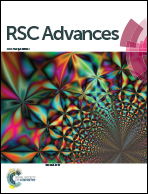Two polymolybdate-based complexes and their graphene composites with visible-light photo-responses†
Abstract
Two polymolybdate-based complexes formulated as (H2L1)2(Mo4O13) (1) and (L2)2(HL2)2(Mo8O25)·7H2O (2) have been hydrothermal synthesized and structurally characterized by single-crystal X-ray diffraction. In complex 1, one-dimensional (1D) [MoV4MoVI4O26]∞8− chain is constructed by vertice-sharing {MoO6} octahedra, and the uncoordinated protonated [H2L1]2+ species link different [Mo8O26]∞8− chains via supramolecular forces. In complex 2, the [Mo8O25]2− moieties are linked by the μ3-[HL2]+ and μ2-L2 ligands into 1D chain. Complex 2 possesses more narrow band gap than complex 1, and it shows stronger photocurrent response than complex 1 under the visible light (650 nm > λ > 350 nm). The different densities of states (DOS) of the two complexes are attributed to their different compositions and frameworks, thus giving rise to their different band gaps. With the addition of graphene into the two complexes, the electroconductivity of the complex/graphene composite material is much improved, and 2/graphene composite material shows much improved electrocatalytic activity for the H2 evolution reaction (HER) than complex 2.



 Please wait while we load your content...
Please wait while we load your content...